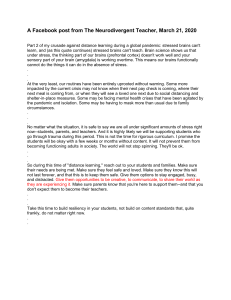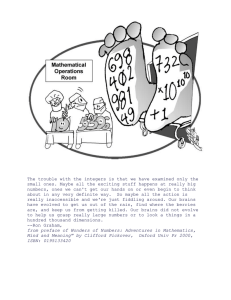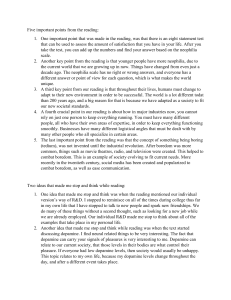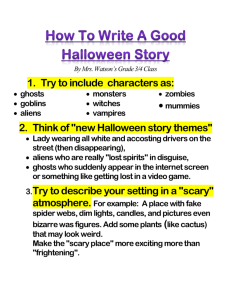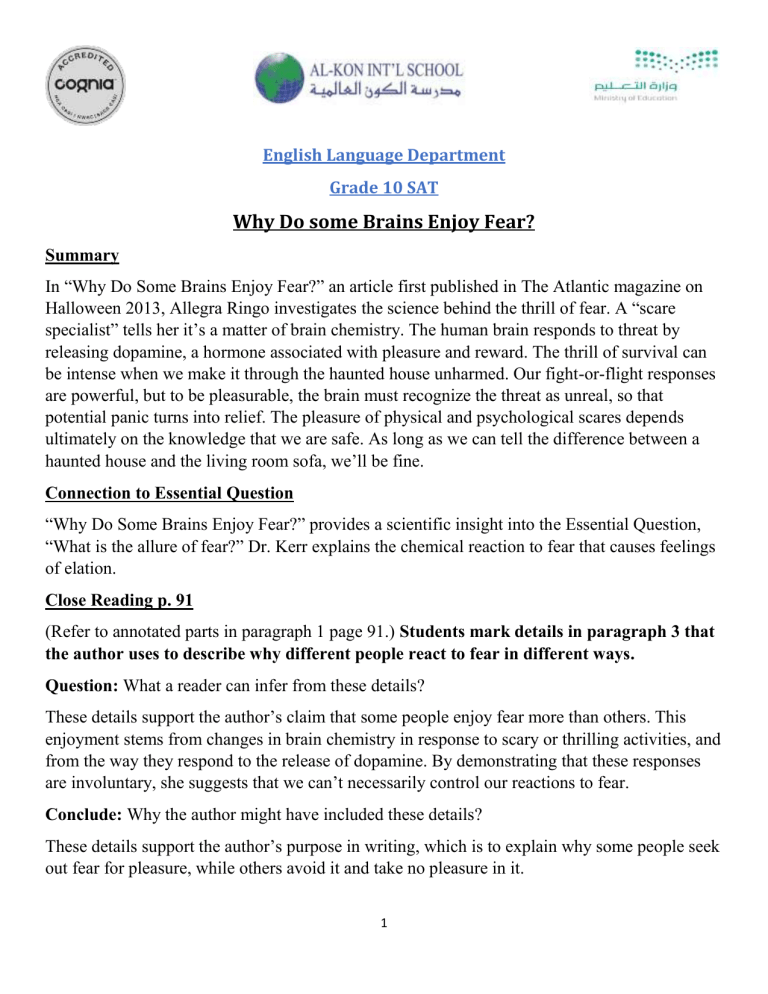
English Language Department Grade 10 SAT Why Do some Brains Enjoy Fear? Summary In “Why Do Some Brains Enjoy Fear?” an article first published in The Atlantic magazine on Halloween 2013, Allegra Ringo investigates the science behind the thrill of fear. A “scare specialist” tells her it’s a matter of brain chemistry. The human brain responds to threat by releasing dopamine, a hormone associated with pleasure and reward. The thrill of survival can be intense when we make it through the haunted house unharmed. Our fight-or-flight responses are powerful, but to be pleasurable, the brain must recognize the threat as unreal, so that potential panic turns into relief. The pleasure of physical and psychological scares depends ultimately on the knowledge that we are safe. As long as we can tell the difference between a haunted house and the living room sofa, we’ll be fine. Connection to Essential Question “Why Do Some Brains Enjoy Fear?” provides a scientific insight into the Essential Question, “What is the allure of fear?” Dr. Kerr explains the chemical reaction to fear that causes feelings of elation. Close Reading p. 91 (Refer to annotated parts in paragraph 1 page 91.) Students mark details in paragraph 3 that the author uses to describe why different people react to fear in different ways. Question: What a reader can infer from these details? These details support the author’s claim that some people enjoy fear more than others. This enjoyment stems from changes in brain chemistry in response to scary or thrilling activities, and from the way they respond to the release of dopamine. By demonstrating that these responses are involuntary, she suggests that we can’t necessarily control our reactions to fear. Conclude: Why the author might have included these details? These details support the author’s purpose in writing, which is to explain why some people seek out fear for pleasure, while others avoid it and take no pleasure in it. 1 Note: An author’s purpose is his or her main reason writing. For example, an author may want to entertain, inform, or persuade the reader. Sometimes an author is trying to teach a moral lesson or reflect on an experience. An author may also have more than one purpose. Close Reading p. 92 Question: What a reader can infer from these details? These details explain that responses to fear can be based on earlier experiences, particularly childhood experiences. The same chemicals that cause people to seek out fear can also create traumatic memories when people have no way of knowing that they are safe from harm. Conclude: Why the author might have included these details? Dr. Kerr included these details to support her claim to be able to explain why some people enjoy the thrill of being scared and some don’t. Note: Evidence is the material proof or logical reasoning that may be cited or employed to support an argument. Evidence can take many forms. For example, in a persuasive essay that appeals to reason, a good writer may use facts, examples, statistics, expert testimony, observations, and personal experiences to support his or her argument. Vocabulary p. 93 1. A stimulus is “something that causes or provokes a response or reaction.” 2. Dissonance means “a lack of agreement or harmony.” 3. Cognitive means “pertaining to the process of thinking.” Close Reading p. 94 Question: What a reader can infer from the author’s word choices? These details suggest that people visiting Barnum’s American Museum not only sought thrills and frights but also wanted to enjoy their visit as a social experience to share with their friends. Conclude: Why the author might have included these details? The author is trying to show that people’s enjoyment of pleasures like modern haunts is nothing new. People’s attraction to fear has been around as long as there have been attractions to scare them. For many, thrill-seeking is a social activity. 2 Note: Diction is a writer’s or speaker’s word choice—the type of vocabulary, the vividness of the language, and the appropriateness of the words to the subject. Diction is an essential feature of a writer’s style and is often a reflection of the writer’s personality. It may be described as formal or informal, plain or ornate, abstract or concrete, ordinary or technical, sophisticated or downto-earth, old-fashioned or modern or even slangy. Comprehension Check p. 95 1. Some individuals feel more effects from the dopamine response than others do, because their brains lack “brakes” on the dopamine release and re-uptake in the brain. 2. We need to know we are in a safe environment. 3. The child was the subject of a science experiment. He was conditioned to be extremely afraid of white rabbits in the 1920s. 4. The article explores our reactions to fear. First, people differ in their response to frightening situations depending on how they process dopamine. Some people enjoy scary situations because overcoming their fear boosts their confidence. To fully enjoy the sensation of fear, thrill-seekers have to be sure that they’re safe. People can be conditioned to be afraid of anything, and experience teaches us the difference between learned fear and innate fear— fear of the known, and fear of the unknown. Each culture has its own scary monsters, many of which seem to inhabit the mysterious borderlands between life and death. Scaring each other has a long and illustrious history, and sharing a terrifying experience is a proven way for people to get to know each other better. Analyze the Text p. 96 1. There is a universal fear of things that do not make sense. These fears are innate, but others are learned, such as Baby Albert who was conditioned to be afraid of white rabbits. Learned fears are a result of socialization. 3 Practice p. 97 Extra Information: 1. Why do some brains fear? Basically, some people's brains lack what Zald describes as “brakes” on the dopamine release and re-uptake in the brain. This means some people are going to really enjoy thrilling, scary, and risky situations while others, not so much. To really enjoy a scary situation, we have to know we're in a safe environment. 2. What is one of the reasons given in "Why Do Some Brains Enjoy Fear?" to explain why people have been scaring themselves and others since prehistoric times? It prepares children for challenging life experiences. 3. What hormone is released during scary or thrilling activities? One of the main hormones released during scary and thrilling activities is dopamine, and it turns out some individuals may get more of a kick from this dopamine response than others do. 4 4. What claim in "Why Do Some Brains Enjoy Fear?" does Dr. Kerr support by referring to the child who was made to fear ordinary rabbits? People can be made to fear almost anything. 5. What is the purpose of fear? The main function of fear and anxiety is to act as a signal of danger, threat, or motivational conflict, and to trigger appropriate adaptive responses. 6. According to Dr. Kerr, what critical information do we need to have in order to enjoy a scary situation? We need to know we are in a safe environment. 5


